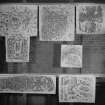Following the launch of trove.scot in February 2025 we are now planning the retiral of some of our webservices. Canmore will be switched off on 24th June 2025. Information about the closure can be found on the HES website: Retiral of HES web services | Historic Environment Scotland
Drainie
Cross Slab (Early Medieval)
Site Name Drainie
Classification Cross Slab (Early Medieval)
Alternative Name(s) Kinneddar Church; Kinnedar Manse; Old Manse Of Kinneddar; Kinnedar; Drainie Manse; Drainie No. 13
Canmore ID 16486
Site Number NJ26NW 3.13
NGR NJ 223 696
Datum OSGB36 - NGR
Permalink http://canmore.org.uk/site/16486
- Council Moray
- Parish Drainie
- Former Region Grampian
- Former District Moray
- Former County Morayshire
Drainie 13, Kinneddar, Moray, shrine panel fragment
Measurements: H 0.46m, W 0.34m, D 0.06m
Stone type: sandstone
Place of discovery: NJ c 223 696
Present location: Elgin Museum (1855.1.13)
Evidence for discovery: found in or prior to 1855; according to Stuart (1856, 40), ‘most of
the other fragments [ ie nos 2-13] were found in old dykes about the Manse, and a few were dug up in the old churchyard’. The old manse stood close to the graveyard and the site of Kinneddar old parish church and early medieval foundation, then located beside a sea loch.
Present condition: the stone has been trimmed to a rectangle for re-use as a building stone, but the top edge is original. The carving is very weathered.
Description
This fragment is part of the upper portion of a panel, carved in relief on one broad face with a plain flat-band moulding along the top and a figural scene below. At the top are the forequarters of a galloping horse, facing left and following the horse in front, of which only the rump and hind legs survive. There is a rider on the second horse, mounted on a saddle-cloth, but the details are blurred. Below the horses are five human figures, all in profile facing left, with prominent eyes, full beards, flowing hair and tunics, but their lower legs are missing and again their details are blurred.
Date range: ninth or tenth century.
Primary references: Stuart 1856, pl 130; ECMS pt 3, 148
Desk-based information compiled by A Ritchie 2018
Note
NJ26NW 3.13 223 696.
No. 13. Elgin Museum, Acc. No. 1855.1.13
Now in Elgin Museum (see NJ26SW 101.13).
(Undated) information in NMRS.
























